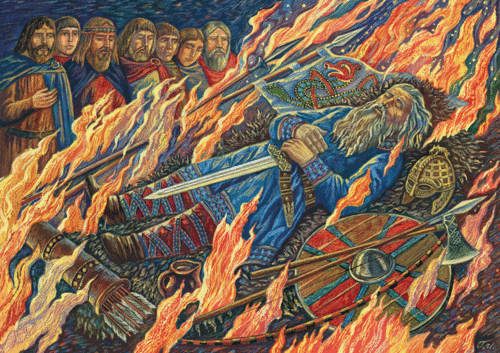The classic Viking funeral conjures up images of a noble Viking lord slowly drifting out to sea in a boat alight with flames, but just how accurate is this image?
There are a number of historical accounts and archeological finds that give us quite a clear impression of the traditions of Viking burial. They did indeed involve a boat, the deceased person was often laid inside a boat or a stone ship, but instead of being cast out to sea, it would usually be buried under stones and soil. An alternative was to burn the body on a funeral pyre.
The deceased would also be buried with an array of grave goods depending on the person’s social standing. While free men were given equipment for riding, tradesmen would be buried with tools, women with jewellery and household tools, while slaves were buried simply to ensure they wouldn’t return to haunt their masters.
The actual ceremonies were steeped in ritual and tradition, designed to give the deceased strength to continue in the afterlife. To bury a corpse incorrectly was to risk the dead person returning to haunt the family and curse them to lose more members. Rumours of these ghostly visions forced some families to ‘kill’ the deceased again by cutting the head from the corpse, or putting a stake through the body.
One eyewitness account tells the story of the burial of a chieftain. One of the chief’s female slaves volunteered to join him in the afterlife. This slave was closely guarded while also given a large amount of intoxicating drinks. The chief’s body was laid on a ship surrounded by weapons and the meat or two sacrificed horses, a hen and a cock. The slave girl was sent from tent to tent to have intercourse with the various men of the camp and they said to her “Tell your master that I did this because of my love to him!” It was believed that this would transmit life force into the dead chieftain. The slave was then taken to the ship, where she was beaten and raped before being hung and stabbed. The entire ship was then set alight, once it had burned away they erected a barrow over the ashes and carved the name of the chieftain into a piece of birch wood.
For your monthly injection of history knowledge, subscribe to All About History today.
